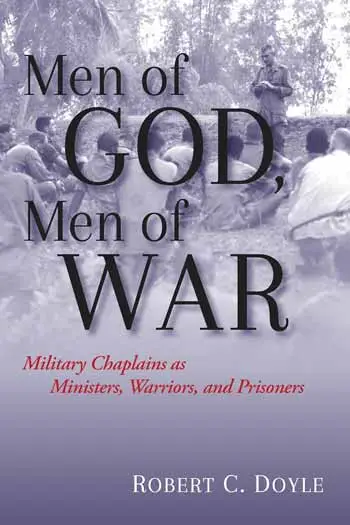By Robert C. Doyle.
Annapolis, MD: Naval Institute Press, 2024.
ISBN 978-1-68247-418-1. Notes.
Bibliography. Index.
Pp. xiv, 205. $34.95.
Robert Doyle is a distinguished retired professor of American history with a long-standing interest in prisoners of war (POWs). Author of several books on this topic, he served as a consultant to the Joint Personnel Recovery Agency. Here, Doyle focuses on the experiences of military chaplains who served and were seriously wounded, killed, or captured. He also describes some of the experiences leading to recognition of valor, with awards including the Medal of Honor.
Each of the eleven chapters focus on a specific war or period in American history. The chapters address the American Revolution through the War on Terror. The heart of each chapter features stories of challenges, pain, suffering, injury, and sometimes death experienced by men who answered the call to serve the spiritual and often physical needs of soldiers. Some chaplains experienced the horrors of captivity as POWs. Chaplains joined other POWs who died in camps, on marches between camps or the “Hell Boats” en route to Japan in World War II when they were sunk by American forces. Doyle offers vignettes of chaplains to illustrate the difficult ministries they shared.
Some of the stories are well-known, such as the Four Chaplains of World War II on the USAT Dorchester passing their life jackets to sailors. Some stories are emerging recently in greater detail, such as Medal of Honor recipient Chaplain Emil Kapaun, who cared for POWs in Korea before his death and is in consideration for sainthood in the Roman Catholic Church. Two outstanding POWs managed to complete a life of military service culminating in time as Chief of Chaplains for their respective branches: Chaplain Francis Sampson (Army) and Chaplain Robert Preston Taylor (Air Force). Chaplains received awards including the Medal of Honor, and Doyle recounts the stories of recipients such as Lieutenant Commander Joseph T. O’Callahan in 1946 and more recently Chaplain Kapaun for service as a POW in Korea. Many of the chaplains Doyle cites have little written about them and have been forgotten over time. All have stories worth sharing. Doyle is to be commended for bringing them out of the archival recesses and introducing them to new readers.
Interspersed with the stories about individual chaplains, Doyle provides some insights regarding the changes in the role of military chaplains in the past 250 years, and the organizational development of the chaplaincy across all military services. Doyle notes the development of how chaplains were selected and trained. He also makes note of issues like uniforms, unique insignia, rank and compensation, and the change in status to non-combatants. Although not the prime focus of the book, the changes are an interesting part of the story of military chaplain history and a helpful addition to anyone so interested.
The dust jacket comment by Major General William D. Razz Waff is an accurate invitation to current and future chaplains. Here he writes: “…this remarkable book is one every chaplain candidate and chaplains completing their chaplaincy basic training should have as a reference point for what might be asked of them.” This is a good recommendation from the Executive Director of the Military Chaplain’s Association. Doyle’s writing will pique the reader’s interest, and his notes will make further research easier for those who want to know more about the men whose service he highlights. Doyle completes his work with extensive chapter notes to ground his research and a detailed bibliography includes books, articles, films, and websites. The title is accurate as the book focuses on the era when all military chaplains were men. One hopes someone as gifted a writer as he will write the wartime history of female chaplains. Men of God, Men of War is an insightful read for anyone, especially chaplains, interested in learning more about the service of chaplains in our nation’s armed forces during wartime.
Chaplain (Lieutenant Colonel) Kenneth M. Ruppar, USA-Ret.
Chesterfield, Virginia
